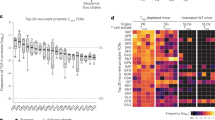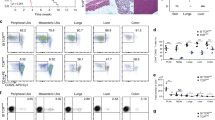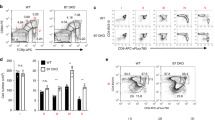Abstract
The relationship between the T cell receptor (TCR) repertoires used by self-reactive transcription factor Foxp3–positive (Foxp3+) CD4+ regulatory T cells (Treg cells) and nonregulatory T cells with autoimmune potential is unclear. Here we found that the TCR repertoire of thymic Treg cells in TCRβ-transgenic mice was diverse and was more similar to that of peripheral Treg cells than that of nonregulatory T cells, suggesting that thymic Treg cells make a substantial contribution to the peripheral Treg cell population. Activated T cells in Foxp3-deficient mice, which lack Treg cells, 'preferentially' used TCRs found in the TCR repertoire of Treg cells in Foxp3-sufficient TCRβ-transgenic mice, suggesting that these self-reactive TCRs contribute to the pathology of Foxp3-deficient mice. Our analyses suggest that Treg cells and potentially pathogenic autoimmune T cells use overlapping pools of self-reactive TCRs.
This is a preview of subscription content, access via your institution
Access options
Subscribe to this journal
Receive 12 print issues and online access
$209.00 per year
only $17.42 per issue
Buy this article
- Purchase on Springer Link
- Instant access to full article PDF
Prices may be subject to local taxes which are calculated during checkout






Similar content being viewed by others
References
Sakaguchi, S., Sakaguchi, N., Asano, M., Itoh, M. & Toda, M. Immunologic self-tolerance maintained by activated T cells expressing IL-2 receptor α-chains (CD25). J. Immunol. 155, 1151–1164 (1995).
Powrie, F., Leach, M.W., Mauze, S., Caddle, L.B. & Coffman, R.L. Phenotypically distinct subsets of CD4+ T cells induce or protect from chronic intestinal inflammation. Int. Immunol. 5, 1461–1471 (1993).
Sakaguchi, S. Naturally arising CD4+ regulatory T cells for immunologic self-tolerance and negative control of immune responses. Annu. Rev. Immunol. 22, 531–562 (2004).
Maloy, K.J. & Powrie, F. Regulatory T cells in the control of immune pathology. Nat. Immunol. 2, 816–822 (2001).
Shevach, E.M. CD4+CD25+ suppressor T cells: more questions than answers. Nat. Rev. Immunol. 2, 389–400 (2002).
Taguchi, O. et al. Tissue-specific suppressor T cells involved in self-tolerance are activated extrathymically by self-antigens. Immunology 82, 365–369 (1994).
Seddon, B. & Mason, D. Peripheral autoantigen induces regulatory T cells that prevent autoimmunity. J. Exp. Med. 189, 877–882 (1999).
Jordan, M.S. et al. Thymic selection of CD4+CD25+ regulatory T cells induced by an agonist self-peptide. Nat. Immunol. 2, 301–306 (2001).
Hsieh, C.-S. et al. Recognition of the peripheral self by naturally arising CD25+CD4+ T cell receptors. Immunity 21, 267–277 (2004).
Walker, L.S., Chodos, A., Eggena, M., Dooms, H. & Abbas, A.K. Antigen-dependent proliferation of CD4+CD25+ regulatory T cells in vivo. J. Exp. Med. 198, 249–258 (2003).
Van Santen, H.-M., Benoist, C. & Mathis, D. Number of T reg cells that differentiate does not increase upon encounter of agonist ligand on thymic epithelial cells. J. Exp. Med. 200, 1221–1230 (2004).
Olivares-Villagomez, D., Wang, Y. & Lafaille, J.J. Regulatory CD4+ T cells expressing endogenous T cell receptor chains protect myelin basic protein-specific transgenic mice from spontaneous autoimmune encephalomyelitis. J. Exp. Med. 188, 1883–1894 (1998).
Fontenot, J.D. & Rudensky, A.Y. A well adapted regulatory contrivance: regulatory T cell development and the forkhead family transcription factor Foxp3. Nat. Immunol. 6, 331–337 (2005).
Sakaguchi, S. & Sakaguchi, N. Thymus and autoimmunity: capacity of the normal thymus to produce pathogenic self-reactive T cells and conditions required for their induction of autoimmune disease. J. Exp. Med. 172, 537–545 (1990).
Fontenot, J.D., Dooley, J.L., Farr, A.G. & Rudensky, A.Y. Developmental regulation of Foxp3 expression during ontogeny. J. Exp. Med. 202, 901–906 (2005).
Apostolou, I. & von Boehmer, H. In vivo instruction of suppressor commitment in naive T cells. J. Exp. Med. 199, 1401–1408 (2004).
Chen, W. et al. Conversion of peripheral CD4+CD25− naive T cells to CD4+CD25+ regulatory T cells by TGF-β induction of transcription factor Foxp3. J. Exp. Med. 198, 1875–1886 (2003).
Walker, M.R. et al. Induction of Foxp3 and acquisition of T regulatory activity by stimulated human CD4+CD25− T cells. J. Clin. Invest. 112, 1437–1443 (2003).
Belkaid, Y., Piccirillo, C.A., Mendez, S., Shevach, E.M. & Sacks, D.L. CD4+CD25+ regulatory T cells control Leishmania major persistence and immunity. Nature 420, 502–507 (2002).
Yu, W. et al. Continued RAG expression in late stages of B cell development and no apparent re-induction after immunization. Nature 400, 682–687 (1999).
Fontenot, J.D. et al. Regulatory T cell lineage specification by the forkhead transcription factor Foxp3. Immunity 22, 329–341 (2005).
Correia-Neves, M., Waltzinger, C., Mathis, D. & Benoist, C. The shaping of the T cell repertoire. Immunity 14, 21–32 (2001).
Klein, L., Khazaie, K. & von Boehmer, H. In vivo dynamics of antigen-specific regulatory T cells not predicted from behavior in vitro. Proc. Natl. Acad. Sci. USA 100, 8886–8891 (2003).
Gavin, M.A., Clarke, S.R., Negrou, E., Gallegos, A. & Rudensky, A. Homeostasis and anergy of CD4+CD25+ suppressor T cells in vivo. Nat. Immunol. 3, 33–41 (2002).
Chen, Z., Benoist, C. & Mathis, D. How defects in central tolerance impinge on a deficiency in regulatory T cells. Proc. Natl. Acad. Sci. USA 102, 14735–14740 (2005).
Fontenot, J., Gavin, M.A. & Rudensky, A.Y. Foxp3 programs the development and function of CD4+CD25+ regulatory T cells. Nat. Immunol. 4, 330–336 (2003).
Hori, S., Nomura, T. & Sakaguchi, S. Control of regulatory T cell development by the transcription factor Foxp3. Science 299, 1057–1061 (2003).
Khattri, R., Cox, T., Yasayko, S.-A. & Ramsdell, F. An essential role for Scurfin in CD4+CD25+ T regulatory cells. Nat. Immunol. 4, 337–342 (2003).
Bennett, C.L. et al. The immune dysregulation, polyendocrinopathy, enteropathy, X-linked syndrome (IPEX) is caused by mutations of FOXP3. Nat. Genet. 27, 20–21 (2001).
Apostolou, I., Sarukhan, A., Klein, L. & von Boehmer, H. Origin of regulatory T cells with known specificity for antigen. Nat. Immunol. 3, 756–763 (2002).
Itoh, M. et al. Thymus and autoimmunity: Production of CD25+CD4+ naturally anergic and suppressive T cells as a key function of the thymus in maintaining immunologic self-tolerance. J. Immunol. 162, 5317–5326 (1999).
Fisson, S. et al. Continuous activation of autoreactive CD4+CD25+ regulatory T cells in the steady state. J. Exp. Med. 198, 737–746 (2003).
Bhandoola, A. et al. Peripheral expression of self-MHC-II influences the reactivity and self-tolerance of mature CD4+ T cells: evidence from a lymphopenic T cell model. Immunity 17, 425–436 (2002).
Wong, P., Goldrath, A.W. & Rudensky, A.Y. Competition for specific intrathymic ligands limits positive selection in a TCR transgenic model of CD4+ T cell development. J. Immunol. 164, 6252–6259 (2000).
Mach, N. et al. Differences in dendritic cells stimulated in vivo by tumors engineered to secrete granulocyte-macrophage colony-stimulating factor or Flt3-ligand. Cancer Res. 60, 3239–3246 (2000).
Magurran, A.E. Ecological diversity and its Measurement 95 (Princeton University Press, Princeton, New Jersey, 1988).
Colwell, R.K. EstimateS: Statistical estimation of species richness and shared species from samples. Version 6. User's Guide and application (http://viceroy.eeb.uconn.edu/estimates; 1997).
Casrouge, A. et al. Size estimate of the αβ TCR repertoire of naive mouse splenocytes. J. Immunol. 164, 5782–5787 (2000).
Acknowledgements
We thank K. Forbush for flow cytometry of thymic and peripheral T cells in RAG-GFP mice; M.A. Gavin, L. Williams and J. Kim for discussions and critical reading of the manuscript; and J. Rasmussen, V. Giudicelli (ImMunoGeneTics, Montpellier, France), L. Karpik and M.-W. Liang for technical assistance. Supported by the National Institutes of Health (C.-S.H. and A.Y.R.), the Howard Hughes Medical Institute (A.Y.R.), the Arthritis Foundation–American College of Rheumatology (C.-S.H.) and the Burroughs Wellcome Fund (C.-S.H.).
Author information
Authors and Affiliations
Corresponding authors
Ethics declarations
Competing interests
The authors declare no competing financial interests.
Supplementary information
Supplementary Fig. 1
CDR3 spectratyping of TCRs from Foxp3− and Foxp3+ T cells. (PDF 493 kb)
Supplementary Fig. 2
Phenotypically naive T cells in Foxp3− mice utilize TCRs found in the non-Treg subset in wild-type mice and are typically non-self-reactive. (PDF 617 kb)
Supplementary Table 1
Unique TRAV14 CDR3 sequences in Foxp3+ CD4+ T cell subsets. (PDF 305 kb)
Supplementary Table 2
Unique TRAV14 CDR3 sequences in Foxp3− CD4+ T cell subsets. (PDF 8 kb)
Supplementary Table 3
Analysis of Foxp3gfp Tcra+/− Tcrb-transgenic TRAV14 CDR3 sequences. (PDF 9 kb)
Rights and permissions
About this article
Cite this article
Hsieh, CS., Zheng, Y., Liang, Y. et al. An intersection between the self-reactive regulatory and nonregulatory T cell receptor repertoires. Nat Immunol 7, 401–410 (2006). https://doi.org/10.1038/ni1318
Received:
Accepted:
Published:
Issue Date:
DOI: https://doi.org/10.1038/ni1318
This article is cited by
-
A guide to thymic selection of T cells
Nature Reviews Immunology (2023)
-
Factors that influence the thymic selection of CD8αα intraepithelial lymphocytes
Mucosal Immunology (2021)
-
RelB regulates the homeostatic proliferation but not the function of Tregs
BMC Immunology (2020)
-
Treg cell-based therapies: challenges and perspectives
Nature Reviews Immunology (2020)
-
Long-term tolerance of islet allografts in nonhuman primates induced by apoptotic donor leukocytes
Nature Communications (2019)



